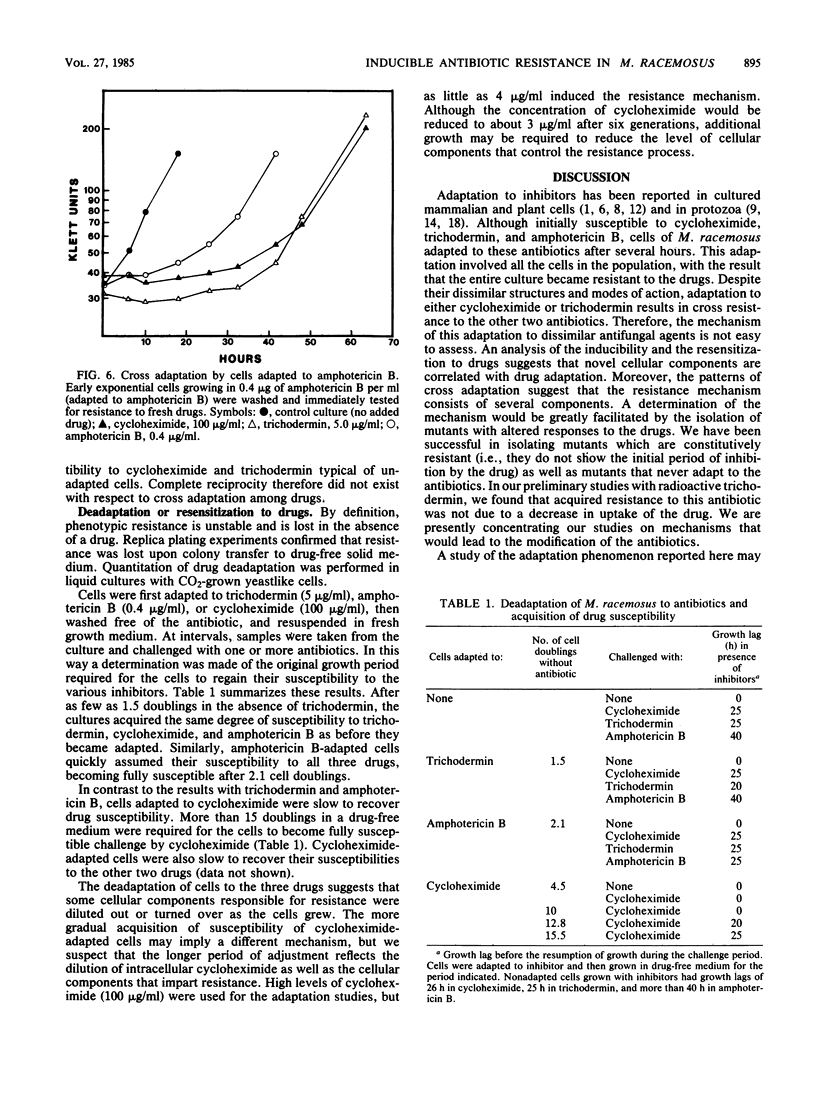Abstract
The dimorphic fungus Mucor racemosus exhibited a single-step, inducible resistance to cycloheximide, trichodermin, and amphotericin B. Cells adapted to inhibitory levels of the antibiotics after 12 to 40 h. The adaptation involved all the cells in the population and was not the result of the selection of resistant mutants. Adaptation to one drug provided cross resistance to other, dissimilar drugs. Resistance was lost within several generations of growth in the absence of the inhibitors.
Full text
PDF




Selected References
These references are in PubMed. This may not be the complete list of references from this article.
- Adair G. M., Carver J. H. Unstable, non-mutational expression of resistance to the thymidine analogue, trifluorothymidine in CHO cells. Mutat Res. 1979 Apr;60(2):207–213. doi: 10.1016/0027-5107(79)90185-4. [DOI] [PubMed] [Google Scholar]
- Bodenhoff J. Development of strains of Cryptococcus neoformans resistant to nystatin, amphotericin B, trichomycin and polymyxin B. Acta Pathol Microbiol Scand. 1968;73(4):572–582. doi: 10.1111/j.1699-0463.1968.tb03215.x. [DOI] [PubMed] [Google Scholar]
- Capek A., Pavlíková L., Simek A., Brůna L., Janata V., Budesínský Z. Antimicrobial agents. XIX. Detoxication mechanism of some strains of Candida albicans. Folia Microbiol (Praha) 1973;18(6):522–523. doi: 10.1007/BF02876800. [DOI] [PubMed] [Google Scholar]
- Capek A., Simek A., Kejda J. Antimicrobial agents. 28. Inducible resistance in species of the genus Candida. Folia Microbiol (Praha) 1973;18(4):304–307. doi: 10.1007/BF02868047. [DOI] [PubMed] [Google Scholar]
- Capek A., Simek A., Leiner J., Weichet J. Antimicrobial agents. VI. Antimycotic activity and problems of resistance. Folia Microbiol (Praha) 1970;15(4):314–317. doi: 10.1007/BF02869060. [DOI] [PubMed] [Google Scholar]
- Davies M. E., Exworth C. P. Transient inhibition by cycloheximide of protein synthesis in cultured plant cell suspensions: a dose response paradox. Biochem Biophys Res Commun. 1973 Feb 20;50(4):1075–1080. doi: 10.1016/0006-291x(73)91516-7. [DOI] [PubMed] [Google Scholar]
- ESPOSITO R. E., HOLLIDAY R. THE EFFECT OF 5-FLUORODEOXYURIDINE ON GENETIC REPLICATION AND MITOTIC CROSSING OVER IN SYNCHRONIZED CULTURES OF USTILAGO MAYDIS. Genetics. 1964 Nov;50:1009–1017. doi: 10.1093/genetics/50.5.1009. [DOI] [PMC free article] [PubMed] [Google Scholar]
- Fox M., Radacic M. Adaptational origin of some purine-analogue resistant phenotypes in cultured mammalian cells. Mutat Res. 1978 Feb;49(2):275–296. doi: 10.1016/0027-5107(78)90166-5. [DOI] [PubMed] [Google Scholar]
- Frankel J. An analysis of the recovery of tetrahymena from effects of cycloheximide. J Cell Physiol. 1970 Aug;76(1):55–63. doi: 10.1002/jcp.1040760109. [DOI] [PubMed] [Google Scholar]
- Griffin D. H., Sullia S. B., Salkin I. F. Resistance of selected saprobic and zoopathogenic fungi to cycloheximide. J Gen Microbiol. 1978 Mar;105(1):127–134. doi: 10.1099/00221287-105-1-127. [DOI] [PubMed] [Google Scholar]
- Harris M. Genetic and adaptive differences in the expression of drug resistance in hybrid cells. Somatic Cell Genet. 1979 Nov;5(6):793–808. doi: 10.1007/BF01542642. [DOI] [PubMed] [Google Scholar]
- Orlowski M., Sypherd P. S. Location of protein synthesis during morphogenesis of Mucor racemosus. J Bacteriol. 1978 Jan;133(1):399–400. doi: 10.1128/jb.133.1.399-400.1978. [DOI] [PMC free article] [PubMed] [Google Scholar]
- Roberts C. T., Jr, Orias E. On the mechanism of adaptation to protein synthesis inhibitors by Tetrahymena. Facilitation, cross adaptation, and resensitization. J Cell Biol. 1974 Sep;62(3):707–716. doi: 10.1083/jcb.62.3.707. [DOI] [PMC free article] [PubMed] [Google Scholar]
- Salkin I. F. Adaptation to cycloheximide: in vitro studies with filamentous fungi. Can J Microbiol. 1975 Sep;21(9):1413–1419. doi: 10.1139/m75-211. [DOI] [PubMed] [Google Scholar]
- Salkin I. F., Hurd N. Quantitative evaluation of the antifungal properties of cycloheximide. Antimicrob Agents Chemother. 1972 Mar;1(3):177–184. doi: 10.1128/aac.1.3.177. [DOI] [PMC free article] [PubMed] [Google Scholar]
- Sarachek A. Population changes induced in Candida albicans by nalidixic acid. Mycopathologia. 1979 Sep 17;68(2):105–120. doi: 10.1007/BF00441090. [DOI] [PubMed] [Google Scholar]
- Silberstein G. B., Hooper A. B. The effect of the herbicide 2,4,5 trichlorophenoxy acetic acid (245T) on the growth and metabolism of Tetrahymena pyriformis. J Cell Physiol. 1975 Apr;85(2 Pt 1):331–338. doi: 10.1002/jcp.1040850219. [DOI] [PubMed] [Google Scholar]


